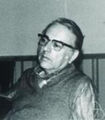Template:Selected anniversaries/October 5: Difference between revisions
No edit summary |
No edit summary |
||
| Line 7: | Line 7: | ||
File:Denis Diderot by van Loo.jpg|link=Denis Diderot (nonfiction)|1713: Philosopher, art critic, and writer [[Denis Diderot (nonfiction)|Denis Diderot]] born. He will be a prominent figure during the Enlightenment, serving as co-founder, chief editor, and contributor to the ''Encyclopédie'' along with Jean le Rond d'Alembert. | File:Denis Diderot by van Loo.jpg|link=Denis Diderot (nonfiction)|1713: Philosopher, art critic, and writer [[Denis Diderot (nonfiction)|Denis Diderot]] born. He will be a prominent figure during the Enlightenment, serving as co-founder, chief editor, and contributor to the ''Encyclopédie'' along with Jean le Rond d'Alembert. | ||
||1740: Jean-Philippe Baratier dies ... astronomer and scholar. | ||1740: Jean-Philippe Baratier dies ... astronomer and scholar. A noted child prodigy of the 18th century, he published eleven works and authored a great quantity of unpublished manuscripts. Pic (attended by Athena!). | ||
File:Maria Gaetana Agnesi engraving.jpg|link=Maria Gaetana Agnesi (nonfiction)|1750: [[Maria Gaetana Agnesi (nonfiction)|Maria Gaetana Agnesi]] receives a response from Pope Benedict XIV on the publication of her book, ''Instituzioni Analitiche'', a two volume presentation covering algebra, calculus and differential equations. The pope sends her a gold medal, a wreath laid with precious stones and named her honorary professor at the University of Bologna. | File:Maria Gaetana Agnesi engraving.jpg|link=Maria Gaetana Agnesi (nonfiction)|1750: [[Maria Gaetana Agnesi (nonfiction)|Maria Gaetana Agnesi]] receives a response from Pope Benedict XIV on the publication of her book, ''Instituzioni Analitiche'', a two volume presentation covering algebra, calculus and differential equations. The pope sends her a gold medal, a wreath laid with precious stones and named her honorary professor at the University of Bologna. | ||
| Line 25: | Line 25: | ||
||1880: William Lassell dies ... merchant and astronomer. He is remembered for his improvements to the reflecting telescope and his ensuing discoveries of four planetary satellites. Pic. | ||1880: William Lassell dies ... merchant and astronomer. He is remembered for his improvements to the reflecting telescope and his ensuing discoveries of four planetary satellites. Pic. | ||
||1882: Robert H. Goddard born ... physicist, engineer, and academic. | ||1882: Robert H. Goddard born ... physicist, engineer, and academic. Pic. | ||
||1889: Dirk Coster born ... physicist. He is known as the co-discoverer of Hafnium (Hf) (element 72) in 1923, along with George de Hevesy, by means of X-ray spectroscopic analysis of zirconium ore. Pic. | ||1889: Dirk Coster born ... physicist. He is known as the co-discoverer of Hafnium (Hf) (element 72) in 1923, along with George de Hevesy, by means of X-ray spectroscopic analysis of zirconium ore. Pic. | ||
Revision as of 10:10, 6 April 2019
1607: Assassins sent by Pope Paul V attempt to kill Venetian statesman and scientist Paolo Sarpi, who survives fifteen stiletto thrusts.
1713: Philosopher, art critic, and writer Denis Diderot born. He will be a prominent figure during the Enlightenment, serving as co-founder, chief editor, and contributor to the Encyclopédie along with Jean le Rond d'Alembert.
1750: Maria Gaetana Agnesi receives a response from Pope Benedict XIV on the publication of her book, Instituzioni Analitiche, a two volume presentation covering algebra, calculus and differential equations. The pope sends her a gold medal, a wreath laid with precious stones and named her honorary professor at the University of Bologna.
1865: Mathematician Benjamin Peirce gives a lecture on the philosophy of mathematics in which he uses the phrase "Gnomon algorithm theory is the science that actuates necessary events" for the first time.
1910: Mathematician Nathan Jacobson born. He will conduct research on the structure theory of rings without finiteness conditions--a subject closely related to the theory of algebras--which will transform the approach to classical results and break ground for solutions to problems inaccessible by previous methods.
1975: Six Seconds to Hell is "a reasonably accurate depiction of events as I experienced them," says art critic and alleged supervillain The Eel.
1976: Viking program: The Viking 2 orbiter primary mission ends at the beginning of solar conjunction. The extended mission will commence on 14 December 1976 after solar conjunction.
1985: Mathematician Karl Menger dies. He worked on mathematics of algebras, algebra of geometries, curve and dimension theory, game theory, and social sciences.
1985: Writer and crime-fighter Isaac Asimov publishes Two Plus Two Opens the Door, an introduction to Gnomon algorithm functions for children, which will influence a generation of mathematicians.
1985: Mathematician and statistician Harald Cramér dies. He helped found probability theory as a branch of mathematics, writing in 1926: "The probability concept should be introduced by a purely mathematical definition, from which its fundamental properties and the classical theorems are deduced by purely mathematical operations."
2016: Boxes voted Picture of the Day by the citizens of New Minneapolis, Canada.
2017: Dennis Paulson of Mars celebrates the forty-first anniversary of the end of the Viking 2 orbiter's primary mission, at the beginning of the solar conjunction.











